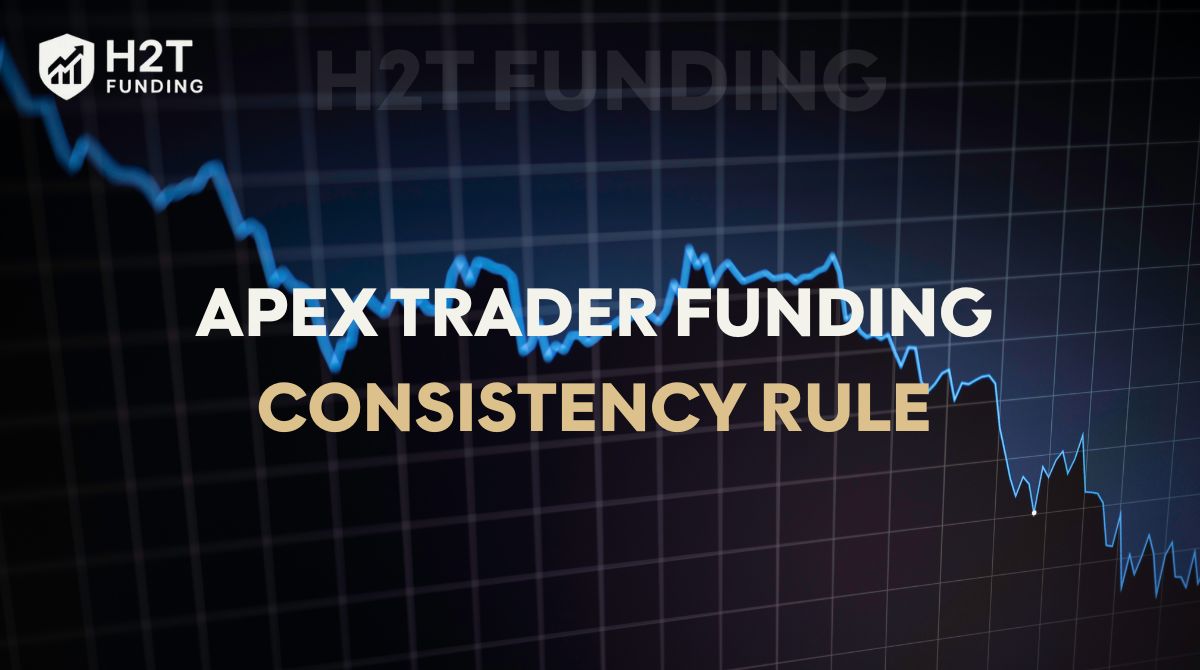If you trade with a prop firm, you have probably heard of the Apex Trader Funding consistency rule. Many traders complete the evaluation successfully, but later receive payout denials because they do not understand this 30% consistency requirement.
The rule ensures that profits grow steadily across trading days rather than depending on a single high-profit session.
Let’s find out now!
Key takeaways:
- The Apex consistency rule limits the best trading day to a maximum of 30% of the total profit.
- The rule applies only to Performance Accounts and Live accounts, not to evaluation accounts.
- Violating this rule can result in denied payouts, delayed approval, or even account closure.
- Consistent profit distribution builds stronger risk management, supports disciplined trading, and helps traders maintain a stable long-term relationship with Apex Trader Funding.
1. What is Apex Trader Funding?
Apex Trader Funding is a proprietary trading firm that gives traders access to company capital once they pass a simulated evaluation. After proving they can manage risk and hit profit targets, traders move on to a Performance Account (PA), where real payouts begin.
Founded in 2021 by Darrell Martin, Apex has quickly grown into a thriving global community with tens of thousands of traders across more than 150 countries. The firm has built its reputation on transparency, fast payouts, and a supportive environment that helps traders stay disciplined and confident.

Apex’s program includes two main stages. The first is the Evaluation Stage. In this phase, traders complete one challenge by reaching the profit target, following the Daily Loss Limit and Trailing Drawdown rules, and trading for at least seven days.
The second is the Performance Account Stage. Traders start receiving real payouts and must follow the 30% Consistency Rule along with other risk management guidelines.
Many traders choose Apex because its evaluation is easier to complete than that of several competitors. The firm also offers frequent discount coupons, clear account rules, and an active community that supports beginners.
From my own experience, this structure helps traders focus on steady performance rather than unpredictable results. Apex Trader Funding payout methods are clear and reward those who trade responsibly. Maintaining contract size consistency, avoiding excessive news trading or hedging, and following proper risk management habits make the trading journey more sustainable.
Apex Trader Funding has earned trust by emphasizing stable growth, fairness, and transparency. Those who stay disciplined and follow the rules usually hit their payout targets sooner and grow more confident with each consistent result.
2. What is the Apex Trader Funding consistency rule?
Before traders can follow any payout guideline, they first need to understand what the consistency rule actually means. This section explains how Apex defines consistency, why it matters for funded traders, and how the 30 percent threshold shapes real trading behavior.
2.1. Apex consistency rule explained: Definition and purpose
The Apex Trader Funding consistency rule sets out how profits should be distributed across trading days in both Performance and Live Accounts. Under this rule, no single trading day can account for more than 30% of the total accumulated profit since the last payout or since the account became active.
This rule does not apply to Evaluation Accounts. It starts working only after traders reach the funded stage. When a payout is made, the calculation resets and begins again from new profits.
The purpose of this rule is to keep fairness among traders, strengthen risk management, and measure real trading skill. It prevents traders from depending on one high-profit day and promotes steady growth built on planning and consistency.
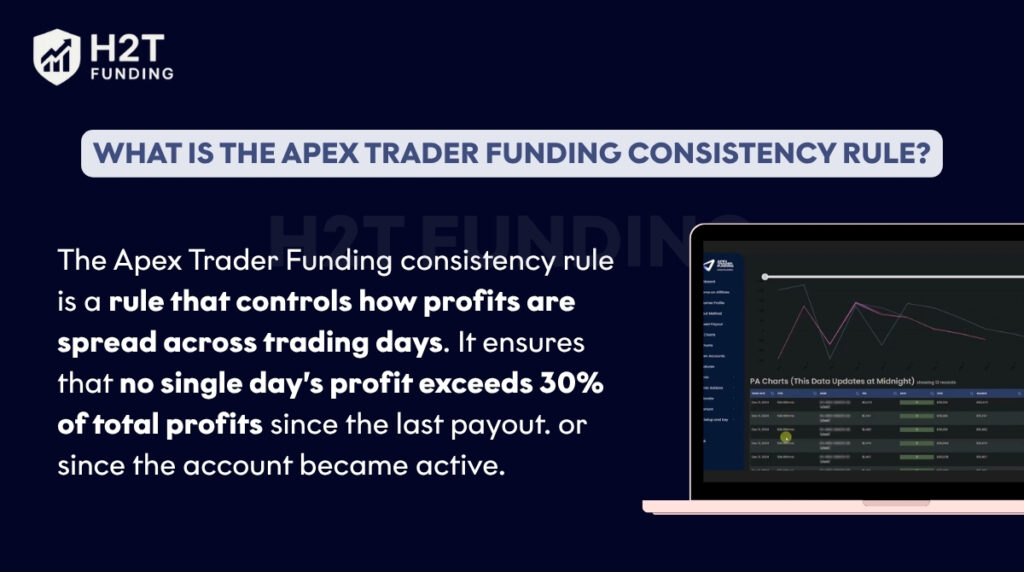
For example, if a trader earns $6,000 in total profit, then no single day should produce more than $1,800. If a day exceeds that number, Apex may delay the payout until the results look balanced again.
2.2. Key principles of trading consistency
Consistency in trading is more than daily numbers. It reflects how a trader prepares, reacts, and manages behavior when the market changes suddenly. To build lasting consistency, funded traders should keep to a few important habits.
- Follow a clear trading plan. Decide on entry, exit, and risk levels before each trade.
- Control risk carefully. Keep drawdowns small and size positions in proportion to account balance.
- Keep contract size stable. Avoid changing lot sizes or switching instruments too often.
- Track performance regularly. Review trades to see patterns and make adjustments.
- Stay calm and avoid emotional trading. Do not chase losses or overtrade after winning days.
- Adapt to market conditions. Change tactics when volatility shifts, but stay inside your plan.
Following these habits shows Apex that profits come from skill and judgment, not luck.
2.3. Application and connection to risk management
The 30% consistency rule applies once a trader receives a Performance Account (PA). It does not apply during the evaluation stage. After each payout, it resets and stays active until the sixth payout or until the trader moves to a Live Account.
Apex Trader Funding risk management framework includes the Consistency Rule, Trailing Drawdown, and Daily Loss Limit. It works together with several key protections.
- Trailing Drawdown: protects equity during losing periods.
- Daily Loss Limit: caps how much can be lost in one day.
- 30% Negative P&L Rule (MAE): limits how far a trade can move against the position.
All these controls work together to protect both the trader’s growth and Apex’s capital. They help keep trading consistent and prevent unnecessary risk.
2.4. Related consistency framework rules
The Apex Consistency Framework includes supporting policies that help maintain stable performance and disciplined trading.
- Scaling Program: limits contract numbers in the early funded stage until growth reaches a defined level.
- 30% Negative P&L Rule: prevents unrealized losses on a single trade from exceeding 30% of total profit.
- Dollar Cost Averaging (DCA): allowed only when used with proper risk control.
- Adding to trades: permitted if done on winning positions with clear reasoning.
- Max Contracts / No Hedging: restricts going beyond the approved contract size or taking opposite positions.
- Semi-automated trading: tools for speed are acceptable, but full automation or AI bots are not.
These combined elements reflect Apex’s structured and transparent philosophy, focusing on long-term consistency over short bursts of luck.
2.5. Consequences of violating the rule
Apex handles violations of the consistency rule seriously. Depending on the case, one or more actions may follow.
- Warning: a reminder to correct performance before requesting a payout.
- Probation: temporary payout suspension or closer review of activity.
- Denied payout: profits held back until results meet the rule’s requirement.
- Termination or ban: repeated or intentional violations may cause account closure and disqualification.
Breaking the consistency rule can harm payout eligibility and reduce trust with Apex. Staying disciplined and consistent remains the most reliable way to earn regular payouts and build long-term success.
3. How to calculate the Apex Trader Funding consistency rule
Knowing how to calculate the Apex Trader Funding consistency rule helps traders stay compliant during payouts. The calculation shows how evenly profits are spread across trading days and confirms performance stability.
The formula is simple:
Minimum Total Profit Required = Highest Profit Day ÷ 0.3
If your total profit is smaller than this result, you have not met the consistency standard.
Example 1:
- Best day profit: $1,500
- $1,500 ÷ 0.3 = $5,000 minimum total profit required
If your total profit is only $4,000, you fail the consistency rule.
Example 2:
- Best day profit: $1,200
- $1,200 ÷ 0.3 = $4,000 minimum total profit required
If your total profit is $4,500, you pass the rule and qualify for a payout.
This rule applies to Performance Accounts and Live accounts, but not to evaluation accounts. The calculation resets after every payout cycle. After six payouts or once you transition to a Live Prop Trading Account, the consistency requirement ends.
Apex provides a built-in consistency rule calculator in the dashboard that tracks your best day, total profit, and percentage in real time. You can also verify results manually using a spreadsheet or trading journal.
Compliance is more than just watching the numbers move. A trader needs to keep contract sizes steady, stay within the daily loss limit, and manage the maximum adverse excursion (MAE) under the 30% Negative P&L Rule. These points sit inside Apex’s wider system of risk control and help profits grow at a smoother pace over time.
A quick look at performance each day often reveals small shifts before they grow into problems. When one trading day ends up carrying too much weight, it makes sense to trade lighter or take smaller gains over the next few sessions to even things out. With steady habits and a clear head, staying compliant turns into something natural rather than something to worry about.
Furthermore:
4. Apex Trader Funding PA account rules
After completing the evaluation phase, traders move on to a Performance Account (PA), where real payouts start to take place. At this point, each trade is expected to follow Apex’s trading rules, which are built to keep accounts stable and protect company capital over the long run.
The following points outline the key payout guidelines and compliance standards that every PA trader should follow carefully under the Apex Trader Funding program.
4.1. Apex Trader Funding daily loss limit
Each Performance Account has a daily loss limit, which caps how much equity can decline within a single trading day. Reaching or exceeding this limit triggers account closure. This safeguard prevents traders from taking oversized risks that could erase several profitable days in one mistake.
Apex’s dashboard displays this limit clearly so traders can monitor it throughout the session. Keeping losses well below this threshold helps maintain eligibility for payouts and demonstrates strong risk management.
4.2. Trailing Drawdown (Safety Net)
Apex uses a Trailing Drawdown, also known as a Safety Net, that follows your equity as profits grow. It moves upward as you earn, but it never moves back down if you lose. If your balance drops below this trailing limit, the account will automatically close.
Many traders view this as a personal “stop-loss” built into the system. Managing it carefully is part of staying compliant with Apex Trader Funding’s risk management expectations.
4.3. Consistency rule (30% profit distribution)
In Performance Accounts and Live Accounts, Apex requires traders to grow profits evenly instead of relying on one lucky day. Under the 30% consistency rule, no single trading day should account for more than thirty percent of the total profit earned since the last payout.
If a day’s result crosses that limit, Apex might hold the payout and ask the trader to continue trading until profits are spread more evenly. The rule resets after every approved payout and is no longer applied once the trader reaches a Live Account or completes the sixth payout.
Most traders who follow this rule develop steadier habits, better emotional control, and stronger confidence in their long-term results.
4.4. Contract scaling and position size
Apex also manages trading exposure through a scaling system. In the early funding stage, traders can only use about half of the maximum contract size. When their account balance grows past the Trailing Drawdown threshold, they gain access to full contract scaling.
If a trader ignores this rule, payouts may be delayed, and the account can revert to a previous balance. The purpose of this rule is to prevent traders from overleveraging or taking oversized positions just to reach profit targets faster.
Respecting scaling rules builds patience and discipline, helping traders maintain consistency and protect their funded accounts.
4.5. 30% Negative P&L Rule (Maximum Adverse Excursion)
The 30% Negative P&L Rule keeps traders from letting a single trade cause excessive loss. This guideline limits how far a position can move against you, also known as Maximum Adverse Excursion (MAE). At the start of each day, unrealized losses should not exceed thirty percent of the account’s profit balance.
If a trader breaks this limit, the payout process restarts, and at least eight new compliant trading days are required. This helps traders stay focused on managing risk instead of reacting emotionally.
Those who stay within the MAE boundaries usually trade with more confidence, experience fewer emotional swings, and achieve steadier performance.
4.6. Additional trading restrictions
Apex has a few extra restrictions to promote fair and skill-based trading. Activities such as news trading, hedging, or fully automated strategies are not permitted. Traders are also discouraged from adding to losing positions unless there is a clear and well-tested plan in place.
The firm allows limited dollar cost averaging (DCA) and partial scaling, but only when the trader maintains a sensible risk-to-reward ratio. Ignoring these guidelines or using high-risk methods can lead to payout reviews and delays.
These restrictions exist to ensure traders rely on skill, planning, and risk control rather than luck or automation. By staying compliant, traders build credibility, protect their payouts, and show that they can perform consistently under real market pressure.
5. Consistency rule illustration
The best way to understand the Apex Trader Funding consistency rule is through examples. Numbers alone can feel distant, but when you see how the rule works in practice, it starts to make sense.
In fact, Apex reviews how profits are spread across trading days before approving a payout. The goal is to reward steady performance rather than one lucky trading day. Many traders, myself included, have realized that this approach encourages patience and reduces emotional pressure.
The firm measures how much each trading day contributes to your total profit. If one day accounts for more than thirty percent of the total, the account fails the check. When this happens, Apex delays the payout until the results are more evenly balanced.
5.1. Example 1: Fail consistency
A trader completes five trading days with the following results:
- Day 1: $2000
- Day 2: $400
- Day 3: $300
- Day 4: $200
- Day 5: $100
The total profit is $3,000. The best day ($2,000) represents 66.6% of the total.
As a result, the account fails the consistency rule because one day carries too much of the overall profit.
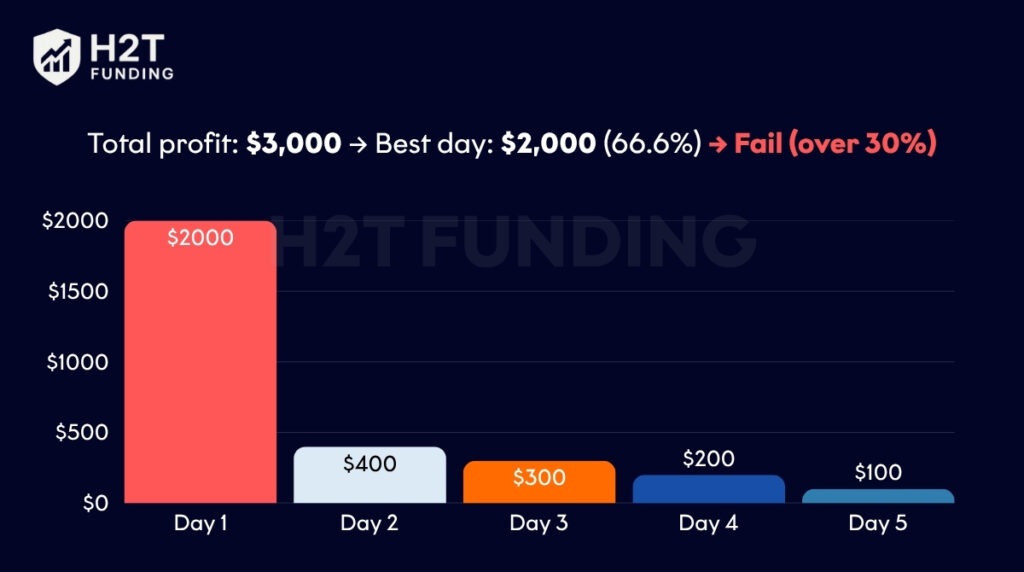
5.2. Example 2: Pass consistency
Another trader records steady results over five days:
- Day 1: $700
- Day 2: $600
- Day 3: $400
- Day 4: $500
- Day 5: $300
The total profit is $2,500. The best day ($700) represents 28% of the total.
This trader passes the rule because no single day exceeds the thirty percent threshold.
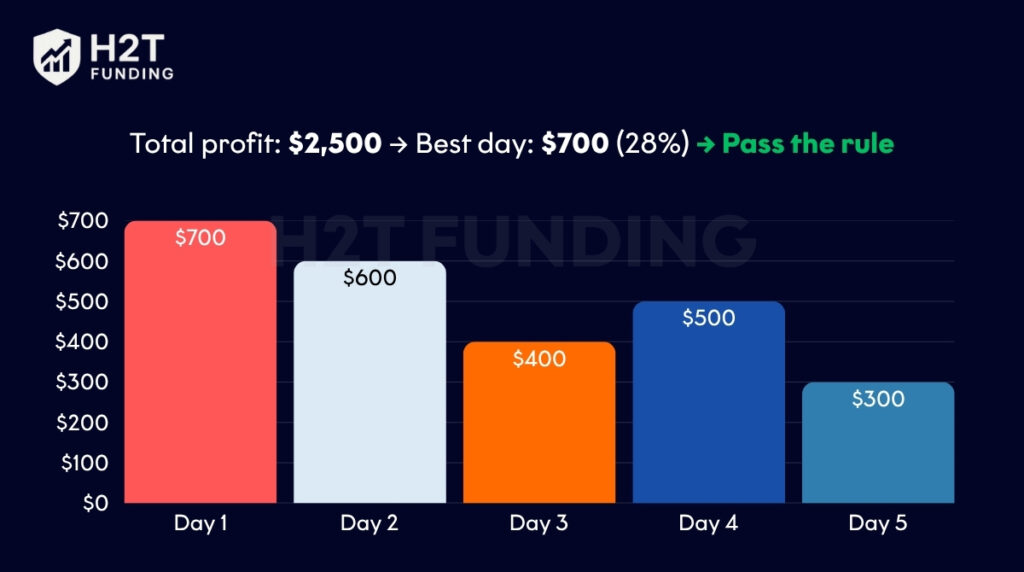
For instance, when I first applied this rule to my own trading data, I noticed how often one good day distorted my equity curve. Learning to spread profits more evenly made my results look steadier and helped me stay calmer during losing days.
Apex automatically resets the consistency calculation after every approved payout. This gives traders a clean start for the next payout cycle. Over time, this process builds stronger habits. Traders learn to control position sizes, avoid oversized trades, and aim for sustainable growth instead of chasing large one-time wins.
Those who achieve consistent profit distribution not only meet the rule but also earn respect within the firm. It reflects solid risk management, emotional balance, and readiness for a long-term partnership with Apex Trader Funding.
6. Why does Apex apply the consistency rule?
The Apex Trader Funding consistency rule serves several important purposes that go far beyond payout approval. It is an essential part of Apex’s effort to encourage disciplined, sustainable trading and protect both traders and the firm.
6.1. To confirm trading skills
Apex uses this rule to identify traders who rely on skill rather than luck. When profits are distributed evenly across several days, it shows that the trader has a working strategy and the discipline to apply it. According to Trading for a Living by Alexander Elder, consistent profitability comes from following a structured system instead of reacting emotionally to market moves.
6.2. To protect company capital
Every funded account represents real money at risk. Allowing traders to rely on a single large win could create unpredictable losses. The consistency rule, along with the Trailing Drawdown and Daily Loss Limit, reduces that risk and helps Apex maintain steady payouts for all traders.
6.3. To promote disciplined behavior
In fact, traders who respect this rule usually show greater control over their emotions. They are less likely to take revenge trades or increase size recklessly after a loss. Apex’s data shows that traders who maintain consistent profits tend to perform better over time and make fewer rule violations.
6.4. To ensure long-term stability
By enforcing the consistency requirement, Apex reduces payout disputes and increases transparency across its community. When traders understand and follow the same standards, both sides can build trust. This clarity allows the relationship between the firm and the trader to remain professional and long-lasting.
6.5. To encourage steady growth
For many traders, this rule becomes a valuable lesson. It reminds them to grow gradually instead of chasing one big payout. As a result, they improve their risk-to-reward ratios, plan trades more carefully, and experience fewer issues during payout reviews.
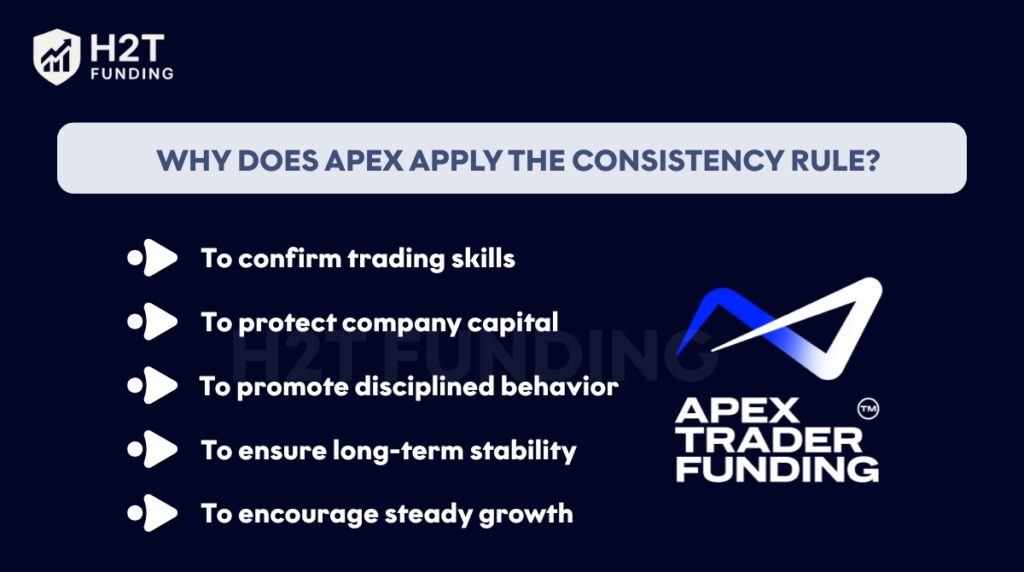
Over time, this consistency rule stops feeling like a restriction and starts working as a guide. It teaches traders patience, structure, and balance. In short, it protects both the trader and the firm while rewarding the kind of discipline that defines a true professional.
7. Complying with how to apply the Apex consistency rule
Several traders of Apex Trader Funding are victims of the consistency rule, yet not by lacking trading ability, but by lacking planning. The consistency rule is simple to adhere to once one knows how to handle profits and position responsibly. Here are real steps to remain compliant and deny payouts.
7.1. Establish profitable prices for each
Prior to each session, make a determination regarding how profitable per day you wish to be.
Let’s say your end goal is $3,000, so aim for about $400 to $600 per day for five to seven sessions. It’s a good, natural progression and holds your best day below the 30% consistency threshold, the Apex calculator threshold.
You can also double-check your data using the 30% consistency rule Apex calculator on the official Apex dashboard.
7.2. Trade smaller contract sizes
Big exposures produce huge spikes of profit that violate the consistency of Apex requirements. Employ smaller contract sizes, observe limitations of scaling of a contract, and keep contract sizes consistent between sessions. It calms down your performance curve and lessens emotional stress.
7.3. Implement a stop-loss for each trade
Every trade must have a pre-determined stop-loss, which honors your 30% Negative P&L Rule and Maximum Adverse Excursion threshold. Making losses short compared to possible benefits maintains the Safety Net and helps prevent overspending your everyday reduction limitation.
7.4. Maintain a precise trading journal
Keep a record of your everyday profits, losses, and number of contracts. A clear record will allow you to see when one day’s profit begins to overwhelm. If a discrepancy is seen, decrease position sizing or accept smaller profits on the next day. Keeping a constant eye on things before the firm’s audit helps prevent it.
7.5. Prevent “all-in” days of trading
Traders consistently fail by attempting recovery of losses or shooting targets too soon. Having reached your day’s target, quit trading. A defensive aspect of disciplined trading and professional risk management is the preservation of gains.
7.6. Track your performance dashboard
Apex offers real-time information on your highest day, total earned, and payout eligibility. Review this dashboard frequently.
If your percentage is over 30%, you are free to rebalance during future sessions prior to requesting a payout submission.
Several traders also post their payoffs and timelines of payoffs in Apex consistency rule Reddit posts, which benefits new traders by understanding how the consistency rule is analyzed for real examples.
7.7. Apply risk-based scaling
If accelerating, apply controlled dollar cost averaging or position layering, remaining within the trading limitations of the firm. Refrain from increasing positions during eventful news occasions, as news trading and hedging give rise to a review of compliance.
By following these steps regularly, it also becomes clear that your winnings are a result of skill and planning, not dumb luck. It also enhances your reputation for proper trading, leading to increased payouts and smooth upgrading to a Live account.
8. Common mistakes when violating consistency rules
Even experienced traders sometimes fail the Apex Trader Funding consistency rule because they overlook simple but critical habits. Most issues can be avoided by improving planning, emotional control, and profit tracking.
8.1. Oversized trading days
Large trades are made by some traders to meet the payout target quickly. This results in a skewed profit curve and violates the consistency requirement of Apex. It catches spikes instantly, by its monitoring mechanism, resulting in denied payouts and even payout holds quite often.
8.2. Ignoring daily profit targets
Without a definitive day-by-day plan, profits swing wildly. A good day can overwhelm a few poor days, contravening your 30% rule. Smaller, steady wins evidence steady risk management, and keep your Performance Account away from gratuitous resets.
8.3. Chasing losses
Traders, after a series of losses, might double their position sizing to make a speedy recovery. Such an emotional approach tends to enhance risk and cross into a higher value of daily loss limitation or Trailing Drawdown. Apex regards it as a display of weak discipline and inconsistent trading psychology.
8.4. Overconfidence after one big win
A large winning day usually convinces traders to exit early from trading. If, however, such a win is more than 30% of the total profit, then the account breaks the rule. Smooth performance across several sessions is the only way of satisfying Apex Trader Funding payout requirements.
8.5. Lack of performance monitoring
Traders pay attention to balance, not to profit allocation. Neglecting a check of a review of the consistency of the Apex ruling calculator or personal record, small violations sum up unobserved. Control, meanwhile, guarantees observance prior to submission of a payout.
8.6. Breaking contract scaling or MAE limits
Breaching contract scaling or a 30% Negative P&L Rule may induce resets/payout denial even when profits appear stable. Both risk behavior and profitability are considered by Apex. Contract size consistency and having desirable greatest adverse excursion amounts are equally as critical as profit allocation.
8.7. Using restricted strategies
Some traders apply automated schemes, hedging, or news trading during periods of high volatility. They are prone to produce short-term spikes but frequently violate trading limitations and contort consistency outcomes. Semi-automated or by-hand systems based on human intuition are less risky for funded accounts.
Avoiding these blunders will keep your account regulatory and allow you to establish a stable, long-term connection to Apex Trader Funding. Repeatability is more about exhibiting controlled, reproducible trading behavior than about loss avoidance.
9. Contrast Apex’s consistency rule with other prop firms
Various proprietary firms employ different ways of measuring trader performance. Some are primarily based on profit and drawdown constraints, whereas other firms, like Apex, add consistency requirements to discover disciplined traders.
The following section compares the consistency rule of Apex Trader Funding with the policies of two other popular firms.
9.1. Apex vs FTMO
FTMO does not apply a consistency rule. Traders are allowed to make all their profit during a single trading day and still be eligible for payout, provided they remain below both the Maximum Daily Loss and the Maximum Loss constraints. This offers increased freedom but also adds an increased risk-taking strategy.
For example, a FTMO trader may make $5,000 on a single day and zero thereafter, yet still succeed, assuming no rules of drawdown are breached. However, Apex applies a consistency rule of 30% via the Apex calculator, whereby profits are spread uniformly across several days of trading. This encourages disciplined trading and helps prevent reliance on one lucky trade.
9.2. Apex vs Topstep
Topstep uses a gentler version of the consistency check. The company looks for gradual improvement over days, but doesn’t set a rigid numerical threshold like Apex’s 30%. Both firms aim for the same thing: to validate traders displaying the ability to perform consistently over a longer period of time.
Under Topstep’s system, inconsistent results can activate a payout review. In contrast, Apex automatically freezes payout approval when its consistency requirement is violated until performance levels out. By being quantitative, Apex’s framework becomes clearer and more measurable.
9.3. Why Apex is unique
Apex is one of the few firms to specify its consistency requirement clearly and quantify it at 30%. The rule appears prominently within the trader dashboard, where statistics refresh on a daily basis. This clear communication helps traders stay compliant without guessing.
In contrast to other companies, Apex places emphasis on both risk management and profit goals through aspects such as the Trailing Drawdown, daily loss limit, and contract scaling controls. Together, these elements form a comprehensive system that rewards sustained skill rather than short-term luck.
Traders who prefer structure and definitive payout criteria tend to favor Apex’s model. It promotes gradual growth, consistent compliance, and smoother transitions from funded to Live accounts.
10. FAQs
Yes. Apex Trader Funding enforces a 30% consistency rule for Performance Accounts and Live accounts. No single trading day can contribute more than 30% of the total profit earned since the last payout or since the account’s activation.
The Apex 30% consistency rule requires traders to keep daily profits balanced. If your best day’s profit is $1,500, the total accumulated profit must be at least $5,000 to qualify for payout. The rule confirms that traders generate steady gains, not one-time spikes.
The 20% consistency rule is not part of Apex’s official policy. Some traders use it as a personal guideline to maintain tighter discipline. It means that no single trading day should exceed 20% of total profits. This self-imposed rule adds a safety margin and helps prevent unexpected payout delays.
A 50% consistency rule would allow one day to represent half of the total profit, but Apex does not accept this. The firm’s system automatically flags any percentage above 30%. Using a 50% threshold will result in a failed consistency check and payout denial.
The rule is very strict. Apex’s software tracks profit distribution daily and calculates the percentage automatically. If your ratio exceeds 30%, the payout is paused until your performance becomes compliant. There are no exceptions or manual overrides.
No. Breaking the Apex consistency requirement results in a denied payout. You must continue trading until new profits rebalance the total so that no single day exceeds 30%. Consistent profit distribution is mandatory for every payout cycle.
No. The rule does not apply to evaluation accounts. It only becomes active once you pass the challenge and begin trading in a Performance Account or a Live account, where payouts are real.
You can check directly in the Apex consistency rule calculator inside your trading dashboard. It shows your best day, total profit, and current ratio in real time. You can also calculate it manually: Highest Profit Day ÷ Total Profit × 100 = Percentage. If the result is 30% or less, your account meets the rule.
If your results exceed the 30% threshold, Apex will delay your payout. You must continue trading until the percentage decreases naturally. Repeated violations may cause account closure or require a new evaluation.
The rule applies to Performance Accounts (sometimes referred to as review or funded accounts) and continues through all Live accounts until the sixth payout. After that, Apex no longer requires consistency checks.
No. The consistency rule is coded into Apex’s payout system and cannot be bypassed. The only solution is to plan your daily trades carefully, maintain contract size consistency, and follow proper risk management.
The official limit is 30%, based on Apex’s most recent clarification in 2025. The company may adjust it in the future, but all updates will appear on the official support site. Traders should always review the latest Apex Trader Funding payout rules before requesting a withdrawal.
11. Conclusion
The Apex Trader Funding consistency rule plays a central role in developing discipline and sustainable growth. It requires traders to maintain balanced profits so that no single day exceeds 30% of total gains. Following this rule ensures smooth payouts, stable performance, and lasting account protection.
Understanding and applying Apex’s core policies, such as the Trailing Drawdown, the daily loss limit, and contract scaling, helps traders build solid professional habits. When combined with effective risk management and a well-defined trading strategy, consistent profits become a natural outcome.
If you are planning to join Apex Trader Funding, focus on profit distribution from the first day. Keep daily results balanced, record every trade in your journal, and check the dashboard frequently to ensure compliance. Consistency is not only a rule; it is the foundation of long-term success in funded trading.
Continue learning more at Prop Firm & Trading Strategies on H2T Funding to strengthen your trading journey.

